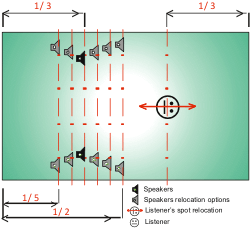Below recommendations apply to the standard symmetrical placement of speakers along the long walls (vis. the scheme) Preliminary the room is divided lengthwise into three parts: the first line (1/3) is for the listener, the second one is for speakers. Lateral axis of the speakers must be always parallel to the walls. Speakers are put close to the walls. Then audition Track 6 (see below Instalife). Moving simultaneously speakers towards each other (2 – 3 cm per move) create sound image of the piano in a massive block. The distance between the speakers should be as wide as possible. Measure and fix the position on the piece of paper. Then move the speakers 20 cm forward and repeat the work. The speakers should be moved listener-wise till the centre of the room and moved back to the line at a distance that is equal to the 1/5 of the room’s length. There will be several dots on the scheme that must be connected. The lines could be both straight and crooked. Place the speakers again on the line at the distance that is equal to 1/3 of the room length on the dots. Using the track 4 and moving the speakers forward and backward along the drawn lines you will create the effect of tambourine moving around. If there is no positive effect try to move the listener’s chair forward-backward. For further tuning use the track number 5. You will definitely find the best position for your speakers. Additional check – tracks 7 and 8. P.S.: At a 1 meter distance from the speaker you will definitely hear the sound of the recording room. Usually the installation procedure of the speakers according to the above mentioned methodology fails to comply with the generally accepted concept. TRUST YOUR EARS BUT NOT GENERAL IDEAS!
Tracks 1, 2, 3 – checking correct speakers phasing. If all connections (equipment, speakers’ filters, cables, interconnects) are correct, the voice of announcer must sound band-wide strictly between the speakers. If the connections are incorrect the voice will sound to the right/left from the speakers. Track 4 – artificial recording of the tambourine circumferential movement around two mikes. The track is used for preliminary location of the speakers. The sound should move steady circle-wise around the listener. Track 5 – natural recording of the tambourine circumferential movement around two mikes. The track is used for preliminary location of the speakers. The sound should move steady circle-wise without any “jumping”, delay on one spot, volume change or moving “left-right”. Track 6 – Checking «integrity” of the piano sound. Should the speakers be placed very wide, the space between them will demonstrate no sound. You should take care while moving the speakers aside and place them as wide as possible. Track 7 – Checking the stage depth Track 8 (Key checking track) – Riding horses sound starts in the left front corner of the premise, passes through the listener and terminates in the right back corner of the room. The motion should be steady, without bounce and delay. Track 9 – The track is packed with bright effects and quiet sounds with sharp sound of triangle. Track 10 – Quiet sound of brush in the right channel should be clearly distinctive in the circle-wise rhythm of the composition. Track 11 – This track is the most difficult one, because the listener must accept the emotional component of a young singer and peculiar sound of piano. Track 12 – The track demonstrates huge acoustic volume of the premise. Track 13 – The track exposes the volume of the train station premise. Track 14 – The track clearly demonstrates quiet sounds of people talking in the station hall, plates’ clatter, etc. Track 15 – Special effects demonstration. Track 16 – The listener must distinctly hear the voices and steps the gradually transferring of from the open space into the closed space (cave). Track 17 – The artificial quiet sound, overhang sound of the bell (2.50 min – 3.40 min) Track 18 – Poignantly recorded sound of bells with the wash of the sea background. Track 19 – Demonstration of the well recorded guitars. Track 20 – Guitar and accordion (the listener should clearly hear the scratch of the accordion’s bellows). Track 21 – Guitar and Saxophone (saxophone with side-tone the so called “ball” original expressive sound). Track 22 – The expressive sound of saxophone (the saxophone finger-holes are well recorded and audible). Track 23 – Natural timbers of the instruments. Track 24 – Additional track is used for components demagnetizing. It should be played at the average and above average volume level.
— First tambourine beats are recorded when the tambourine is between the mikes.
— Following beats are recorded when the tambourine is taken back from the mikes.
— During these movements the premise volume sound should increase trending up.

